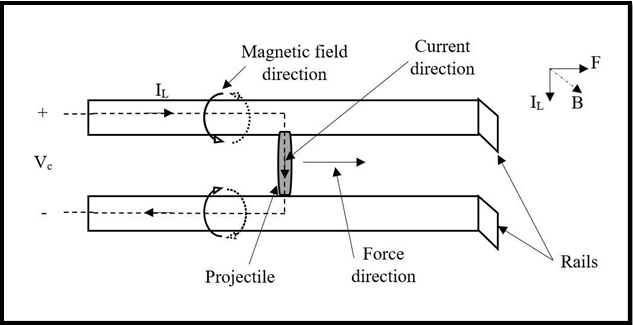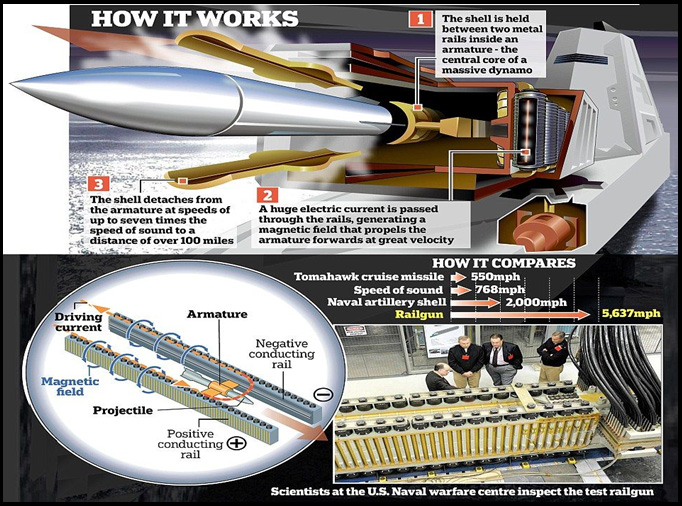“We must ask whether our machine technology makes us proof against all those destructive forces which plagued and wrecked Roman Civilisation. Our reliance upon the power of science and technology to forever ensure the progress of our society, might blind us to some very real problems which cannot be solved by science and technology” – Robert Strausz- Hupe
Introduction
Conventional guns use high pressure to accelerate a projectile by applying pressure inside a barrel. Such high pressure is generated using the expansion of gases through combustion, but due to expansion limits of gas achieving high velocity becomes a constraint. Because of such limitations, projectile shot from conventional guns can barely reach velocity up to 1300 m/s. By using electromagnetic rail gun/ plasma artillery, velocity as high as 20,000 – 50,000 m/s can be achieved theoretically, while pragmatically range of 6000 – 7000 m/s can be achieved. Broadly the two technical racehorses in these advancements have been “Electromagnetic Railgun” pursued by US Navy and “Magnetic Plasma Artillery” claimed as recently as 2018-19 by Chinese PLA force.
The US Navy has been working on implementing the railgun technology in the battlefield for a long time . In 1992 the US Army started a Focused Technology [1] program with the University of Texas. For this program, The Center of Electro-Mechanics (CEM-UT) was created to do research on the electromagnetic launchers such as the electromagnetic railgun. The latest insights into this technology cite how size and cost challenges could be signaling the end of the infamous weapon system. However, to the surprise of absolutely no one, it seems the desire to shoot really big bullets at supersonic speeds has not gone away. Case in point – various reports indicate that the Chinese military is preparing to test magnetised plasma artillery gun capable of firing hypervelocity rounds at six times the speed of sound. The subsequent paragraphs will surmise upon the latest developments of the technology.
Railgun Theory
Electromagnetic launchers have very diverse applications. They can be used from launching loads as small as a projectile to loads as large as a space shuttle. Because of such flexibility in its configuration and its parameters, electromagnetic launchers are getting very popular. Still, there exist some areas in which improvements are needed as launcher’s efficiency is quite low. Research has been done in areas such as pulsed power supply technology, high impulsive current switching, arc quenching at the barrel’s end, projectile design as well as increase in the life of railgun for overcoming those challenges. The electromagnetic railgun is one such electromagnetic launcher which consists of two parallel rails kept at some distance.
An electromagnetic railgun is used for accelerating projectiles with the use of electromagnetic energy. It consists of two rails set parallel to each other with some distance between the rails. A projectile is kept in that gap between the rails, which forms a closed electrical circuit. Current with high amplitude is passed through the circuit to create the force required to move the projectile. It works on a very basic electromagnetic concept called the Lorentz Force Law, which can be given by ?=??×? where, F is the force acting on the projectile, I is the current passing through the projectile, l is the length of the projectile and B is the magnetic field generated by the current. This concept can be visualized using Figure 1. As it can be seen, current passes through the rails as the direction shown in Figure 1. Because of the current flow, magnetic field is generated in the downward direction. Based on the Lorentz’s Force Law, due to this magnetic field and current, the projectile experiences force in the outward direction. Thus, the projectile moves forward because of that force which can be seen in Figure 1. Even if the current’s direction is flipped, it will produce the force in outward direction only because the magnetic field generated will be switched to the upward direction.

Figure 1: Visualisation of the Lorentz Force Law in the Railgun
In railgun, high impulsive current is provided by the input power supply to achieve the required force. For generating this high impulsive current, different techniques have been implemented to date and research has been done to efficiently supply the impulsive current to the railgun system. Usually, a capacitor is used as a source of power. It is discharged to generate the impulsive waveform of current required for the railgun. But there exist other more efficient ways to supply impulsive current to the rail gun system. Research has been done to increase the efficiency of the input power supply. Pulse forming networks seems to be the solution to this low efficiency of the railgun system. Design and optimisation of the pulsed power supply system was studied by Ju Lan, in which different parameters of the pulsed power supply were weighted and desired performance was achieved. This gave the inspiration to achieve the desired performance by optimising different parameters for this project. High current passes through the railgun system because of which high copper loss occurs in the railgun that results into decrease in the efficiency of the railgun. As railgun is a long-range shooting weapon, it must provide necessary force to the projectile by means of electrical energy to hit the target. Therefore, it is required to formulate a control scheme to minimise the losses while hitting the target accurately. Projects are under formulation for a novel optimisation strategy to reduce the copper loss occurring in the system while hitting the target within set accuracy.

The Magnetised Plasma Artillery
The Chinese military recently published a notice [2] inviting researchers to devise a weapon that sounds like a sort of electromagnetic rail gun – which uses magnetism instead of gunpowder to fire shells – that several nations are developing. But actually deploying railguns has been hampered by the size of the weapon and especially the vast amount of electrical energy needed to propel a shell to speeds of greater than Mach7. Despite years of research and vast sums of money, the U.S. Navy appears less than optimistic about fitting railguns on its warships. But Chinese scientists believe that magnetised plasma artillery will be so light and energy-efficient that it can be mounted on tanks. The patented Chinese technology, can be installed on tanks and self-propelled guns, the specification said. Chinese military analysts predict the new technology would extend the range of a conventional 155-millimeter self-propelled howitzer from 30-50 kilometers to 100 kilometers. The plasma layer might also reduce friction between the barrel and rounds, making the weapon more accurate.
Unlike the railgun, which is driven by electricity in generating about the same speed for a round that weighs twice as much, the technology for these guns is a bit more theoretical. Ideally, a current artillery gun would be retrofitted with a magnetised coating placed on the exterior of the tube or barrel. Working with this material on the outside, a magnetic field is created via a magnetic field generator placed on the inside. The Chinese military patent explains how the magnetised plasma could theoretically enhance the artillery’s power. First, a magnetic field is created inside the barrel using a magnetised material coating on the exterior and an internal magnetic field generator. Then, when the artillery is fired, the tremendous heat and pressure inside the firing tube ionizes some of the gas, turning it into plasma and forming a thin, protective magnetised plasma sheath along the inner wall of the barrel.
The developers believe the plasma will decrease friction while providing heat insulation, thus extending the power and range of the artillery piece without jeopardizing the structural integrity of the cannon or negatively affecting the overall service life of the weapon.
The Invention of Magnetised Plasma Artillery
An invention patent [3] discloses a magnetised plasma artillery. A tube of the artillery is provided with a magnetic field, wherein a direction of the magnetic field directs to a muzzle along an axial direction of the tube, and an intensity of the magnetic field is in an attenuated distribution from an inner wall of the tube to an axial line of the tube. When the artillery fires, under the action of the magnetic field, gas in the tube can be ionized into plasmas, and a plasma sheath is formed on the inner wall of the tube.
The magnetised plasma sheath formed on the inner wall of the tube of the magnetised plasma artillery exhibits pressure anisotropy and has a thermal insulation effect, which can greatly reduce the radial force on the tube of the artillery, greatly increase the projectile impetus, greatly improve the heat resistance of the tube, and prolong the service life.
The above magnetised plasma artillery forms the plasma sheath under the action of the magnetic field by means of charged particles generated in high-temperature gas produced by explosion of propellant powder. Therefore, if the concentration of the charged particles in the high-temperature gas produced by explosion of the propellant powder can be further increased, the capability of protection of the magnetised plasma sheath of the magnetised plasma artillery to the tube of the artillery can be further greatly improved, the heat resistance of the tube can be greatly improved, and the service life of the tube can be prolonged. Therefore, it is particularly necessary to further make an in-depth analysis of effects of gas temperature on plasma thermal insulation characteristics, effects of plasma density on the plasma thermal insulation characteristics, and effects of magnetic field intensity and magnetic field direction on the plasma thermal insulation characteristics.
A testing device [4] has also been patented for study of a magnetised plasma artillery and gunpowder. The testing device comprises a pedestal, wherein a top end of the pedestal is provided with a sliding slot for mounting a buffer device, which penetrates through an upper part of the pedestal along a front-rear direction.
Conclusion
The ibid technologies ipso facto are one of the greatest technologies in artillery and cannon warfare. The technology has called for an inevitable “Weapon & Arms Race” among the nations. The technologies in addition to military parlance, has space applications involving electromagnetic coils and superconducting magnets. It may also be a new tide in space launchers and missile technology. The future roadmap will certainly see the powerful militaries of the world acquiring or rather developing these plasma artillery or railguns in their inventories.
—————————
[1] Paper on Design and Optimization of Elctromagnetic Railgun by Michigan Technological University circa 2018.
[2] Article on China to test magnetized plasma artillery on 18 Feb 2019.
[3] Application No. CN 201510137072.5, published as CN 104697397B on Jun. 15, 2016, titled “MAGNETISED PLASMA ARTILLERY”.
[4] Patent No. 10378849 on 13 Aug 2019 by PEOPLE’S LIBERATION ARMY, ARMY ACADEMY OF ARMORED FORCES




